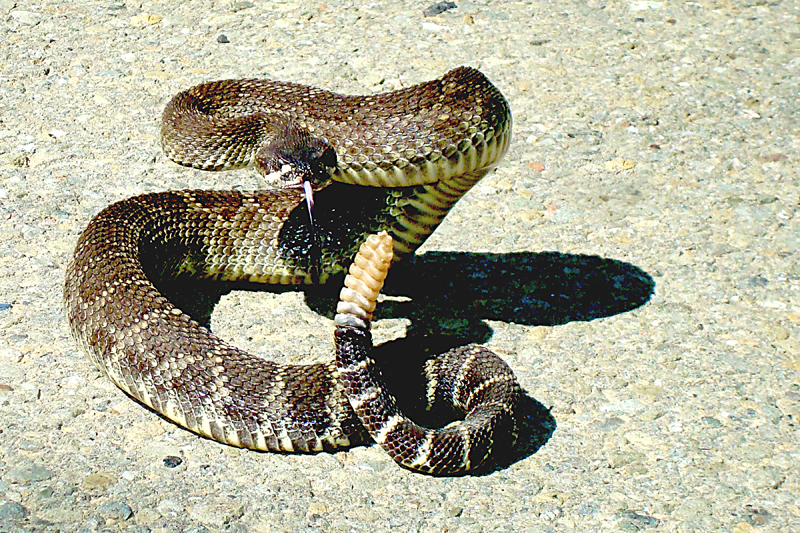It’s snake season in Contra Costa County clear into October

 CONTRA COSTA COUNTY, CA (August 2, 2024) — Like us, snakes came out to bask in the sunshine this spring. But don’t forget: snake season lasts as long as it is warm … that means into October.
CONTRA COSTA COUNTY, CA (August 2, 2024) — Like us, snakes came out to bask in the sunshine this spring. But don’t forget: snake season lasts as long as it is warm … that means into October.
The Mt. Diablo region is home to several beautiful snakes, all of which are important to our ecosystem – including the rattlesnake. Others include whip snakes, gopher snakes, king snakes and garter snakes. Some even eat other snakes.
People can mistake a gopher snake for a rattlesnake since both have a diamond pattern and both tend to be brownish, with some variations in color within each species. The gopher snake is much more slender with a narrow head, whereas the rattlesnake tends to be somewhat stout for its length and has a fat, diamond-shaped head as well as a rattle at the tail end (surprise!).
To add to the confusion, gopher snakes sometimes shake their tails to appear more ominous if they feel threatened.
Keep your pets safe
The Northern-Pacific rattlesnake is the only venomous species in our region. If you are out with your dog, it is important to keep an eye out for rattlers and, ideally, help your dog avoid these snakes. Tips include using a shorter leash, avoiding tall grasses (this helps keep ticks away as well) and paying close attention to where your pups are placing feet and noses.
Another consideration is avoidance training, so dogs learn to be repelled by the snake rather than drawn to it out of curiosity or prey drive.
When you live in an area that rattlesnakes call home, make sure you have fencing that doesn’t allow a snake to enter your yard, if possible. Smaller mesh fencing can help fill in holes at the bottom of wood fences that don’t touch the ground to keep your pets (and the snakes) out of harm’s way.
Keeping snakes out is great, but not always possible. Maintaining a tidy and trimmed yard, especially where dogs, cats and humans might be walking, is helpful since snakes often hide under plants and bushes when it gets a little warm for them in direct sun. Cleaning areas around bird feeders is also important so as not to attract snake snacks, like rodents.
Watch where you step if it is dark out as snakes may settle in at dusk on warm pavement near homes.
Snake bites
If your pet does get bitten by a rattlesnake or even if you think it might have been, immediate veterinary care is important. Rattlesnake bites cause severe pain, swelling, bruising and necrosis (dying off of skin in the area of the bite). The systemic effects can be serious, hitting multiple organs including the kidneys, liver, nervous system and heart. If the animal is bitten near its face or neck, the swelling can cause difficulty breathing.
Though rattlesnake bites can be fatal, with good and timely veterinary care, death from snake bites is rare. Sometimes there is enough local damage to require ongoing care, including surgery to close larger wounds.
The vet will assess the severity of damage and systemic effects of the venom. Occasionally a bite can be minor, such as if it goes through the lip and very little venom is injected into your pet. Other times, and seemingly more often with younger rattlers, the snake injects a large amount of venom with the bite – causing more extensive local and systemic damage.
Typically, the vet will perform lab work to evaluate the severity of systemic signs, including a complete blood count with cytology to look at red blood cell appearance. Affected red cells (echinocytes) look spiny like a sea urchin due to the venom’s effect on the red blood cell surface. Sometimes this is how veterinarians can be sure the patient has a snake bite vs. other trauma if a no one witnessed a snake bite.
Chemistry analysis can assess kidney and liver function, which can often be affected, as well as a check of blood clotting times, heart injury markers, blood pressure, etc.
Generally, vets treat pets with IV fluids to help with clinical signs of systemic shock and low blood pressure. This also helps flush toxins from the body. Pain medications are extremely important, as rattlesnake bites tend to be very painful. Vets sometimes give antibiotics or antihistamines to prevent secondary infections and allergic reactions. Therapeutic laser can help lessen severity of the wound, ease local pain and enhance healing.
Antivenin
Antivenin is a product made from horse serum that helps neutralize rattlesnake venom in the body. Vets can administer it intravenously to try to lessen the symptoms and help get the pet out of crisis more quickly. Antivenin can be pricey, but vets generally believe it helps if given in the first four hours after the bite.
Antivenin can sometimes cause allergic reactions during administration or occasionally later in a form called serum sickness. Most of the time, allergic reactions improve with briefly stopping administration and restarting more slowly.
You can get a rattlesnake vaccine, though data has not been clear on its benefits and risks. Therefore, veterinarians’ opinions can differ on its use. If one chooses to use the vaccine for a pet, many vets recommend an annual booster in areas where rattlesnake bites occur frequently.
Email questions and comments to drmccabevet@gmail.com.
Read more Being Pet Smart columns by Micki McCabe.

Micki McCabe
Micki McCabe Walls, DVM, DACVIM, FAAVA, is a long-time Clayton resident. The recently retired local veterinarian has an interest in internal and integrative medicine.
